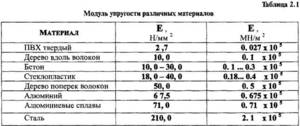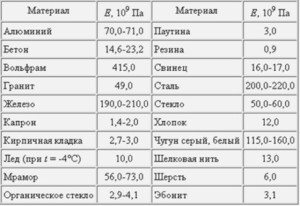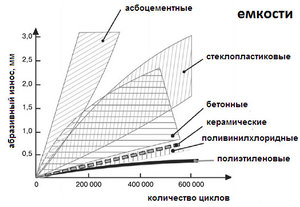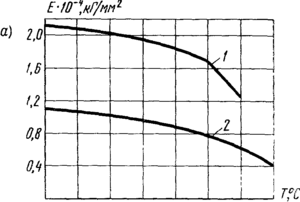
Modulus of elasticity for steel, as well as for other materials
Before, як використовувати якийнебудь матеріал у будівельних роботах, it is necessary to get acquainted with its physical characteristics for that, to know how to handle it, what mechanical impact will be acceptable to him, and so on. One of the important characteristics, to which very often pay attention, is модуль пружності.

Below we consider the concept itself, as well as this value in relation to one of the most popular in the construction and repair work of the material - steel. These indicators in other materials will also be considered, for example.
The modulus of elasticity is what it is?
The modulus of elasticity of any material is called a set of physical quantities, які характеризують здатність якого=небудь твердого тіла пружно деформуватися в умовах додатка до нього сили. It is expressed by the letter E.. So it will be mentioned in all the tables, which will go further in the article.
It is impossible to say, that there is only one way to detect the value of elasticity. Different approaches to the study of this quantity have led to this, that there are several different approaches. Below are three main ways to calculate the performance of this characteristic for different materials:

Young's modulus (E) describes the resistance of the material to any tension or compression under elastic deformation. The Young's variant is determined by the ratio of stress to compression strain. It is usually called simply the modulus of elasticity.
- Offset module (G), also called the modulus of rigidity. This method shows the ability of the material to resist any change in shape, but in the conditions of preservation of the norm by it. The shear modulus is expressed by the ratio of shear stress to shear deformation, which is defined as a change in the right angle between the available planes, exposed to tangential stresses. Offset module, by the way, is one of the components of this phenomenon, as viscosity.
- Volumetric modulus (TO), which are also called volumetric compression modules. Даний варіант означає здатність об’єкта з якогонебудь матеріалу змінювати свій об’єм у разі впливу на нього всебічного нормального напруги, which is the same in all its directions. This option is expressed by the ratio of the amount of volumetric stress to the value of relative volumetric compression.
- There are also other indicators of elasticity, which are measured in other quantities and expressed in other respects. Other well-known and popular variants of elasticity parameters are Lamé parameters or Poisson's ratio.
Table of elasticity of materials
Before, how to go directly to this steel characteristic, consider first, as an example and additional information, table, containing data on this value in relation to other materials. Data are measured in MPa.
Modulus of elasticity of different materials
As you can see from the table above, this value is different for different materials, to the same indicator differ, if you take into account one or another option for calculating this indicator. Everyone is free to choose the option of studying indicators, which is more suitable for him. Better, perhaps, consider the Young's modulus, as it is more often applied to the characteristic of this or that material in this respect.
After we have briefly read the data of this characteristic of other materials, let's go directly to the characteristics of separate steel.
To begin with, let's turn to dry figures and derive different indicators of this characteristic for different types of steels and steel structures:

- Modulus of elasticity (E) for casting, гарачекатної арматури з сталей марок, named Article 3 and Article. 5 is equal to 2,1*106 kg / cm ^ 2.
- For steels such as 25G2S and 30HG2S this value is equal to 2*106 kg / cm ^ 2.
- For periodic profile wire and cold drawn round wire, there is such a value of elasticity, equal to 1,8*106 kg / cm ^ 2. For cold-flattened fittings, the figures are similar.
- For strands and bundles of high-strength wire, the value is 2 · 10 6 kg / cm ^ 2
- For steel spiral ropes and ropes with a metal core, the value is 1.5 · 10 4 kg / cm ^ 2, в той час як для тросів з органічним сердечником це значення не перевищує 1,3·10 6 kg / cm ^ 2 .
- Offset module (G) for rolled steel is 8.4 · 10 6 kg / cm ^ 2 .
- Finally, the Poisson's ratio for steel is equal to the value 0,3
This is general data, are given for types of steel and steel products. Each value was calculated according to all physical rules and taking into account all available relationships, which are used to derive the values of this characteristic.
Below is all the general information about this characteristic of steel. Values will be given as modulus of Jung, and the shear modulus, as in some units (MPa), and in others (kg / cm2, newton * m2).
Steel and several different brands
| Material | Indicators of the modulus of elasticity (E, G; N * m2, kg / cm ^ 2, MPa) |
| Steel | 20,6*10^ 10 newton * meter ^ 2 |
| Carbon steel | E =(2,0…2,1)*10^ 5 MPa; G=(8,0…8,1)*10^ 4 MPa |
| Steel 45 | E = 2.0 * 10 ^ 5 MPa; G = 0.8 * 10 ^ 5 MPa |
| Steel 3 | E = 2.1 * 10 ^ 5 MPa; G = 0.8 * 10 ^ 5 MPa |
| The steel is alloyed | E =(2,1…2,2)*10^ 5 MPa; G=(8,0…8,1)*10^ 4 MPa |
The values of the elasticity of steel vary, since there are several modules, which are calculated and calculated differently. It is possible to note that fact, that in principle strongly indicators do not differ, which is in favor of different studies of the elasticity of different materials. But go deep into all the calculations, formulas and meanings are not worth it, since it is enough to choose a certain value of elasticity, to continue to focus on it.

By the way, if you do not express all the values in numerical terms, and immediately take and count completely, then this characteristic of steel will be equal to: E = 200000 MPa or E = 2 039 000 kg / cm ^ 2.
This information will help to understand the very concept of the modulus of elasticity, as well as to get acquainted with the basic values of this characteristic for steel, steel products, as well as for several other materials.
Remember, that the modulus of elasticity is different for different steel alloys and for different steel structures, which contain other compounds. But even in such conditions, it is possible to note that fact, slightly different indicators. The magnitude of the modulus of elasticity of steel depends on the structure. as well as the carbon content. The method of hot or cold treatment of steel also can not greatly affect this figure.




